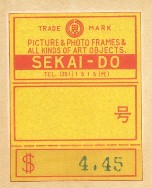Paintings by TerauchiMasterpieces or Tourist Souvenirs?
Landscape paintings signed "Terauchi", done in watercolor / gouache, come up for sale from time to time. Quite often, the sellers attribute these paintings to Terauchi Manjirô (1890-1964), whose works hang in some of the finest museums in Japan. Unfortunately, this mis-attribution has led many novice collectors to pay large sums for what are, in my opinion, mass-produced paintings geared for the tourist trade. Who was Terauchi Manjirô?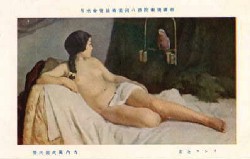 Laurance P. Roberts, in A Dictionary of Japanese Artists, says,
Laurance P. Roberts, in A Dictionary of Japanese Artists, says,
"Western style painter. Born in Osaka. In 1916 graduated from the Tokyo School of Fine Arts, Western-painting division. In 1918 showed with the Bunten. In 1919 became a juror with the Teiten; in 1929 a member of Kofukai. From 1943 to 1950 taught at his alma mater, from 1952 at Tokyo Kyoiku Daigaku (University of Education), and from 1959 at Niigata University. In 1950, received the Japan Art Academy prize, becoming a member of the Academy in 1960. His style is quite realistic in the academic tradition." One of Manjirô's specialties was painting pictures of nude women, an example of which can be seen above. With just one look, it becomes hard to imagine that the same artist produced the landscape paintings signed "Terauchi". Paintings Signed "Terauchi"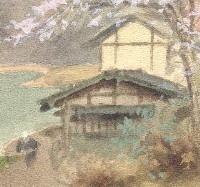 In my collection, I have 11 "Terauchi" paintings.
They are competently executed on watercolor paper, using broader strokes.
There are 2 sets of four-season views (8 pieces in all) about 12" x 8".
The other 3 paintings are larger than that with the smallest being 14" x 10" and the largest 13" x 20".
In my collection, I have 11 "Terauchi" paintings.
They are competently executed on watercolor paper, using broader strokes.
There are 2 sets of four-season views (8 pieces in all) about 12" x 8".
The other 3 paintings are larger than that with the smallest being 14" x 10" and the largest 13" x 20".
Click on the detail to the left for a close look. The figure is skillfully rendered in about 12 strokes, but it is quite clear that the artist didn't spend a lot of time on details. This suggests to me that these paintings are the output of a production environment.
There are a lot of Terauchi paintings that I have observed passing through the on-line auctions and galleries that I monitor. It is doubtful that they are the work of only one artist. I suspect that they are the product of a workshop or atelier where multiple artists were hired to produce paintings for the tourist trade. I found one painting on ebay signed "K. Terauchi". I'm not sure what that means, but it is further evidence that these paintings are not the work of Manjirô Terauchi. Some More Information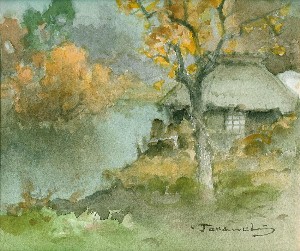
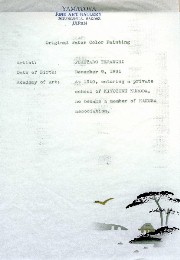
A true reward for taking the time to build and maintain this website is when someone in cyber-space finds one of my pages and sends me some more information. In June, 2004, Mr. Mo Morris wrote: "We have four paintings by the subj artist. They are 4 seasons in watercolor. We bought them at the artists studio on Mt Fuji in the early 1970ís... We have a letter from the studio authenticating the paintings." The letter of authenticity pictured above is from the "Yamatoya Fine Art Gallery" in Hakone, Japan. It names the artist as Fukutaro Terauchi, born 1891, a student of Kiyoteru Kuroda. Prints Signed "Terauchi"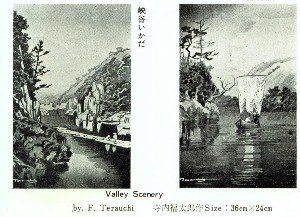 To the left is the lower half of page 27 of a Kyoto Hanga-in sales catalog
(#D on this page
from Koitsu.com) produced in October, 1963 as a special edition for the 1964 Tokyo Olympics.
In Romaji, the artist's name is given as "F. Terauchi".
In Japanese, to the right, it reads "Terauchi Fukutaro saku" or "Made by Fukutaro Terauchi".
To the left is the lower half of page 27 of a Kyoto Hanga-in sales catalog
(#D on this page
from Koitsu.com) produced in October, 1963 as a special edition for the 1964 Tokyo Olympics.
In Romaji, the artist's name is given as "F. Terauchi".
In Japanese, to the right, it reads "Terauchi Fukutaro saku" or "Made by Fukutaro Terauchi".
This catalog listing verifies the artist's given name, Fukutaro. Since there are no Terauchi prints in the 1953 Kyoto Hanga-In catalog, it also gives us the strong implication that Terauchi was an active artist at least some time in the period between 1953 and 1963. Mis-Attributions"Collector's Value Guide"The "Collector's Value Guide to Japanese Woodblock Prints", by Sandra Andacht, on page 186 shows a couple of woodblock prints, published by Kyoto Hanga-In, with the familiar "Terauchi" signature, attributed to Manjirô Terauchi.These are the same designs in the above-mentioned 1963 Kyoto Hanga-In catalog. Around the InternetThere are numerous on-line galleries offering watercolor paintings by "Manjirô Terauchi". Do a Google search and you'll find that this is very common.A Fraudulent Ebay AuctionIn December, 2003, a regular seller of Japanese prints and paintings offered a couple of "Terauchi" signed paintings for sale. His description read:"The signature on this painting matches exactly the signature(s) of two 12" x 19" watercolor paintings by the same artist that sold for $2000.00 at auction in 1991 (Sothebys New York, April 24, 1991 [Lot 82 & Lot 85] Japanese Works of Art - Prints and Paintings). Sotheby's, New York, attributed those paintings to the famous Japanese painter Manjiro Terauchi (1890-1960). Manjiro Terauchi is a graduate of the Tokyo School of Fine Art and a contemporary of Hiroshi Yoshida known for his woodblock prints and paintings."After some effort, I located and purchased a copy of that auction catalog. In fact, Sotheby's did not attribute those paintings to Manjirô Terauchi. They were attributed simply to "Terauchi". Click here for a composite picture of the 2 lots as listed in the Sotheby's catalog. When I notified the seller of his "mistake", he neither answered my email nor modified his auction listing. Christie's September 19, 2000 Auction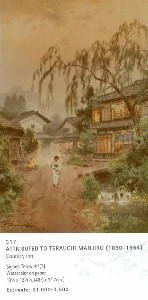 The listing for lot #317 in Christie's September 19, 2000 auction is somewhat inconclusive.
The painting is clearly signed "Terauchi" in Roman script characters and looks like the same signature
as the other watercolors we have been examining.
Christie's catalog says "Attributed to Terauchi Manjiro (1890-1964)" and "Signed Terauchi(?)".
If the Christie's curators were making a positive identification the words "Attributed to" would have
been left off, and there would be no question mark after the signature text.
Therefore, it can't be said that this was a mis-attribution, because they didn't commit to it.
However, in the future, someone may attempt to use this near mis-attribution to justify their own
mis-attribution.
That's why I'm documenting it here.
The listing for lot #317 in Christie's September 19, 2000 auction is somewhat inconclusive.
The painting is clearly signed "Terauchi" in Roman script characters and looks like the same signature
as the other watercolors we have been examining.
Christie's catalog says "Attributed to Terauchi Manjiro (1890-1964)" and "Signed Terauchi(?)".
If the Christie's curators were making a positive identification the words "Attributed to" would have
been left off, and there would be no question mark after the signature text.
Therefore, it can't be said that this was a mis-attribution, because they didn't commit to it.
However, in the future, someone may attempt to use this near mis-attribution to justify their own
mis-attribution.
That's why I'm documenting it here.
In ConclusionThe paintings signed "Terauchi" are plentiful and regularly available in the market-place. Some of them are very nicely done and certainly worth collecting. However, they are not the work of the master artist Manjirô Terauchi. As always, let the buyer beware! |
|
| Home | Copyright 2004-2005 by Marc Kahn; All Rights Reserved |
